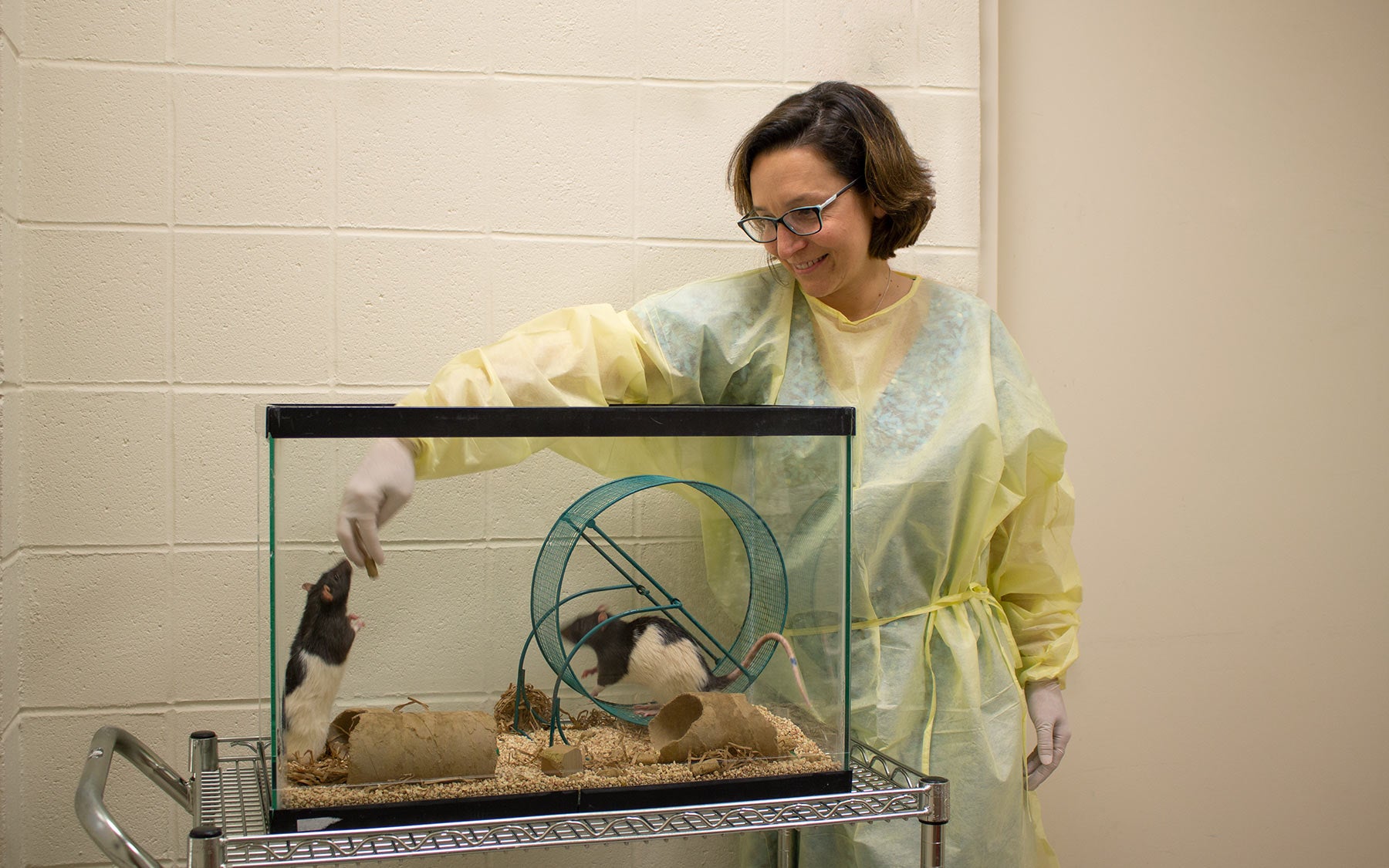Each day, Rachel Rubino makes her rounds around the animal facilities at Cold Spring Harbor Laboratory to make sure all the lab animals are healthy and well-kept. She’ll look in on experiments and chat with researchers to ensure everyone on the team has the necessary training for work they need to do.
Rubino, the attending veterinarian and director of the animal facility at CSHL, has access to all the experiments at the Lab involving work with animal models. “We get a lot of useful information from animals,” she said. Her job is to safeguard them as they help researchers make groundbreaking discoveries. She serves as a gatekeeper that looks out for the best interests of both the animals and the scientists.
Rubino describes herself as an advocate for both animals and science. Everyday, she proves it’s possible to support both.
Most people who work with research animals love those animals; we do it because we care about them.”
Dr. Rachel Rubino, Veterinarian and Director of the Animal Facility
The care of animals used in research studies in the United States has evolved. Prior to 1965, there were no regulations on animal care, but today, scientists not only consider their physical needs, but their emotional well-being as well. Until recently, researchers were discouraged from naming the animals or becoming attached to them in any way. This was due, in part, to the sheer number of animals that passed through laboratories and as a way to stay impartial about objective data points. In many cases, that school of thought has changed. “You’re going to form a bond with those animals whether we tell people to or not, and we want them to, because we want them to care about their welfare,” she said.
Caring and attentiveness prove favorable for scientific research. When researchers in Harry Harlow’s University of Wisconsin lab in the 1950s named their monkeys, they began to recognize individual differences between animals, which led to the discovery of the genetics of personality in monkeys.
“Most people who work with research animals love those animals; we do it because we care about them,” Rubino said. “We want to give them the best lives possible, treat them humanely, and make sure that we’re really doing things in an ethical way.”
The evolution of animal modeling
The National Institute of General Sciences categorizes animals used in research under two groups: research organisms and model organisms. A research organism is a living entity—such as bacteria, birds, etc.—that scientists use to study everything from basic biology to complex systems. This naturalistic study of life can include anything from how the cuttlefish creates camouflages to how the loss of a keystone species, such as bees, can collapse an entire ecosystem. Scientists can also isolate naturalistic observations in lab settings, where they can hone in on more precise questions by controlling external factors like temperature, humidity, light and diet.
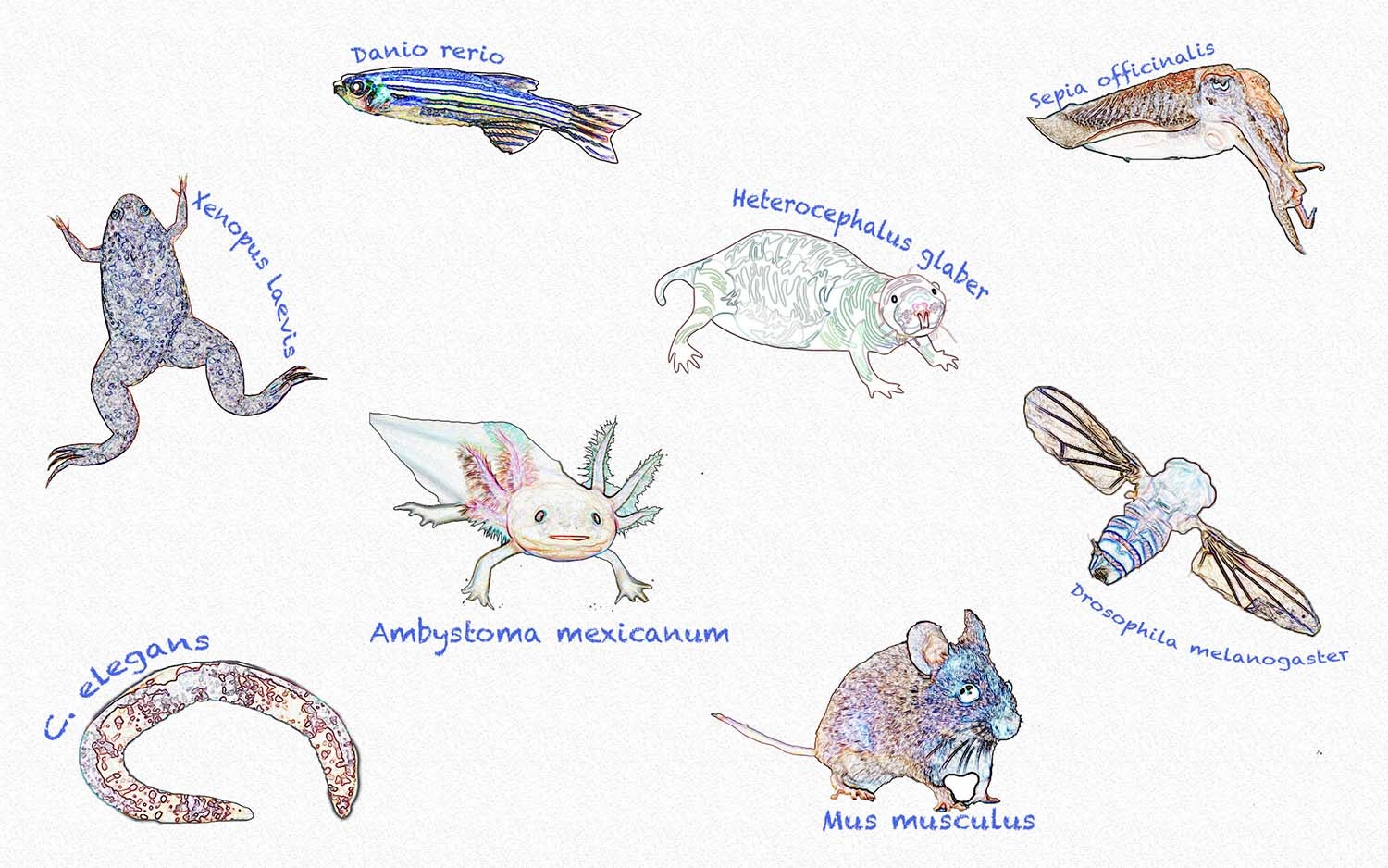
A subset of research organisms that help us understand human biology are called model organisms or animal models. Scientists began using them around the 1930s when experimental biology branched into its own area of research. Columbia University’s Thomas Hunt Morgan, a pioneer in the field, marked a new way to approach science through his work in fruit fly genetics.
Experimental biologists singled out species that were easy to breed and maintain in a laboratory and suitable for the study of a range of biological problems. E. coli and yeast, for example, formed the basis of our knowledge on the inner workings of cells. But as our problems and questions grew more complex, so did the model organisms needed to solve them. Experiments on fruit flies and small, translucent worms shed light on animal development and heredity. Later, researchers graduated to frogs and mice, the first mammalian model organism.
The mouse is now the most prolific model organism used in research. Mice are an ideal experimental candidate because they are easy to keep and have short reproductive cycles. Mice also share 85% of our protein-coding genome, and bear many resemblances to human physiology, including the circulatory, reproductive, digestive, hormonal and nervous systems. This means they can mirror how humans grow, develop disease, and age. While mice are the predominantly used model organism—along with rats, they make up 95% percent of all lab animals—there are many others.
“Each model organism is usually picked for a specific reason,” Rubino said. “We study axolotls because they have powers of regeneration. Naked mole rats are used because they don’t get cancer, and they’re resistant to pain. And so what is different about their physiology that contributes to those characteristics? Those are important things for us to understand, even though they’re not like us.”
Models for life-saving science
Studying human-like organisms is key to developing cures for human illnesses. For this purpose, scientists use animals to model human physiology and disease states. “If it’s the same genetic modification that causes the disease in a human and an animal, we can usually study it more effectively in an animal,” Rubino said.
Cancer biologists at CSHL use mice as a model organism, while neuroscientists use both mice and rats. Voles are used for exploring the neurochemical physiology behind pair bonding, or the changes in the brain that develop after mating that make monogamous vole couples “fall in love.” African clawed frogs and axolotls (a species of amphibians native to Mexico which are coming soon to the Lab) produce oocytes, or large egg cells, that are harvested for studying the structure and function of neurotransmitter receptors and ion channels that regulate fundamental brain activities.
In Rett syndrome, a neurodevelopmental disorder, the pathology is traceable to the failure of a specific gene, called MECP2. A team at CSHL in 2017 published results of experiments in mice suggesting how MECP2 mutations further impair affected individuals later on in life
Outside of medicine, mice are also being used to gain insights into human sociology. Scientists in Zurich, Switzerland are currently investigating how trauma can be inherited across multiple generations.
In addition to monitoring and protecting the welfare of lab animals, Rubino helps researchers choose the best model organism for their studies. She also makes recommendations to alleviate potential pain or distress in the animal that will not affect the researcher’s ability to interpret the science behind the experiment. To do this, she uses her veterinary knowledge of the whole animal physiology of different species to help scientists understand specific cellular mechanisms or molecular pathways that could be targeted or closely studied.
Discoveries in lab animals have also had countless implications for veterinary medicine. A drug used to treat a condition in mice can also be useful for pet ferrets or for a capybara at the zoo. That’s because “you can extrapolate from animals to other animals,” Rubino said. The drug pimobendan, for example, was first developed as a cardiovascular drug for humans but didn’t improve the standard of care. However, it was found to be extremely helpful for dogs with mitral valve disease, and was able to improve their quality of life or extend their lifespan by up to a year. “My dog was on it, actually, for over a year,” Rubino added.
Animal house
The animal facility at CSHL houses all the vertebrate model organisms used by the Lab. A new animal room and deeper cages for the rats are being added. Even though the new cages are not mandatory, Rubino thinks it will be better for the rats’ well-being because it will allow larger rats to be housed socially and accommodate a wider variety of their normal postures.
The mice, voles, and rats stay in cages in large, ventilated and shelved rooms, which are organized by scientist and area of study. Social species like rodents are usually housed in compatible groups. Mice, for example, spend a lot of time sleeping, and grooming one another, so being housed in groups facilitates those behaviors. Mice are nest builders, so they’re given nesting material, as well as chewing blocks. Rats are bigger chewers than the other rodents, so they always get Nylabones, blocks and pieces of wood to gnaw on. Voles are very active, and they have really interesting behaviors, like building complex burrowing systems. Therefore, the staff gives them foraging opportunities—deeper bedding and tunnels and nesting material to manipulate in their microenvironments.
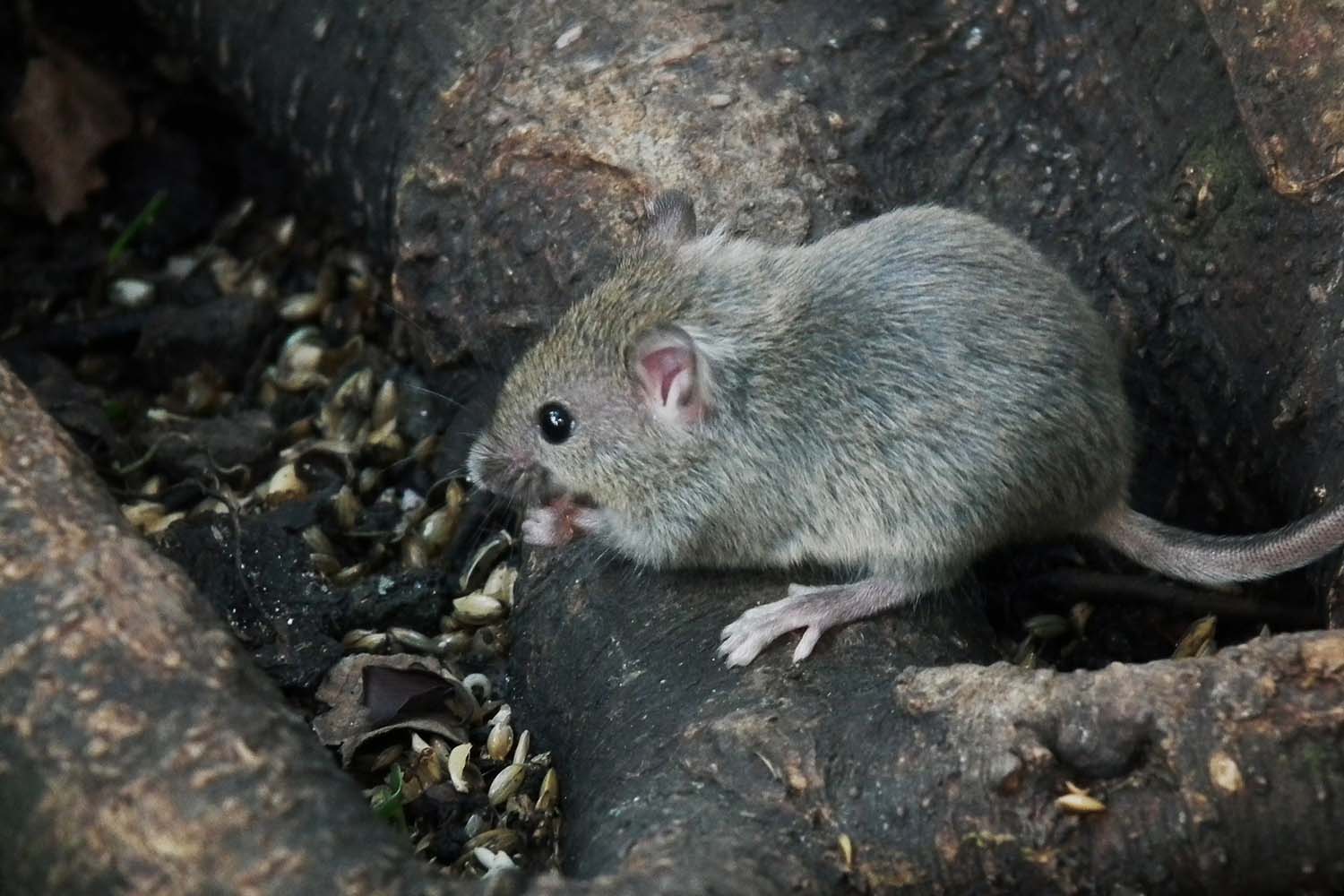
Animal cages are changed and bedding is refreshed once or twice a week, with each rodent getting the right materials for their habitat. One type of bedding is made from ground corn cobs so it is both absorbent and contains pieces of corn that the rodents can forage for. The staff sprinkles rabbit chow in the bedding of the voles, so they can dig around for their food. The voles also get a medley of fresh fruits and vegetables, such as apples, celery, spinach, sweet potatoes and lettuce. All the rodents get soft nest-building structures made from paper or cotton. The voles like to make their nests inside PVC tubing, and mice will make it in a small domed-hut. These supplemental materials and structures are meant to help mimic what the animals would normally do or eat in the wild.
“That’s really what environmental enrichment is. It’s allowing them to exhibit their normal species-specific behaviors,” Rubino said. “And along with that, have a similar time budget, which is a fancy way of saying spending the same amount of time a day on activities as that they’d normally spend if they were out in the wild.”
The Lab’s main neuroscience building has large rat and mice exercise spaces with exercise wheels, toys, and plenty of foraging opportunities. “They get to see it every day,” Rubino said. “They get to go explore there and hang out with their buddies.” Plus, the scientists get to know their animals’ favorite treats.
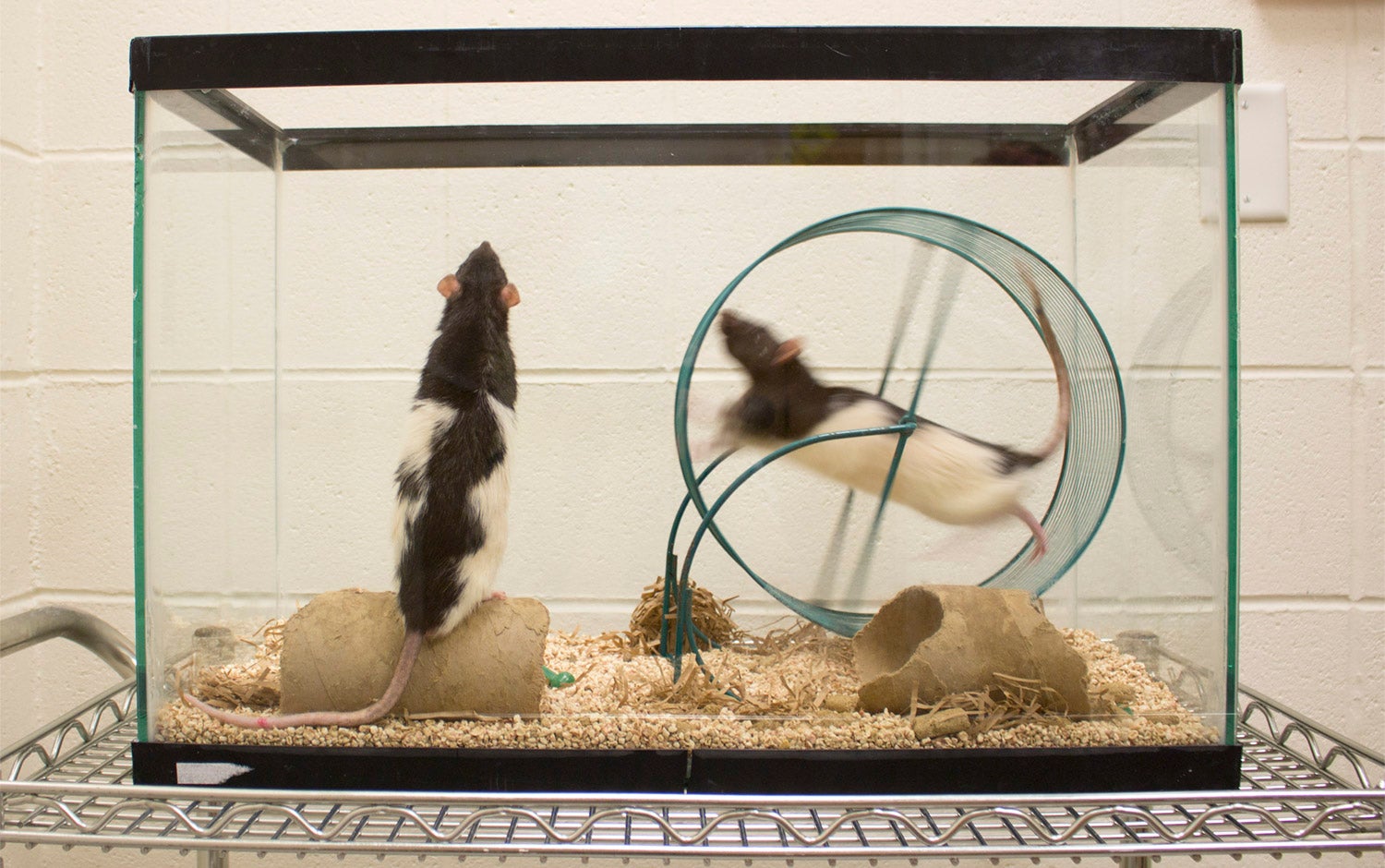
The care and keeping of animals
If the Lab’s closed for any reason, somebody is in charge of checking all of the animals at CSHL. Along with Rubino, the core animal crew includes a director of facility operations, a husbandry manager, about 20 husbandry technicians, one vet technician, and one vet technologist.
“We check their food and water, we change their cages, make sure their cages are clean. We essentially check for health status and make sure that they’re doing okay from a disease perspective, but also that they haven’t developed an injury or condition that we need to address at the same time,” Rubino said. “That includes sprains, scratches, skin conditions, inability to get along with their cage-mates, or other medical problems that develop outside of the intended disease phenotype.”
The crew will place mice pups with a foster mom if their birth mother doesn’t properly take care of them. Bad mice moms will sometimes get paired with good moms to learn better behaviors.
Such dedication to the care of research animals not only affects their welfare but has a big impact on the science. A study published in 2013, for example, found that the regulation-required temperature of the mice room was too cold and negatively impacted mice immunity and experimental outcomes. The researchers discovered that increasing the temperature decreased tumor metastases and growth in their cancer models. “My job is kind of keeping up with those types of studies, and then relaying it to the investigators,” Rubino said.
New observations on animal health and wellness add to a growing and continuously-updated database of regulations. Rubino is well-versed with the sea of regulations and guidance set by various agencies (NIH, AAALAC, USDA, New York State, Public Health Service), and she uses her knowledge to help the scientists achieve their scientific goals.
The regulators inspect the lab frequently to make sure the building and housing compartments are clean, the animals are well, the machines used to test animals are safe, and the personnel follow protocol when working with the animals. Sometimes their visits are by arrangement, but there are also surprise inspections.
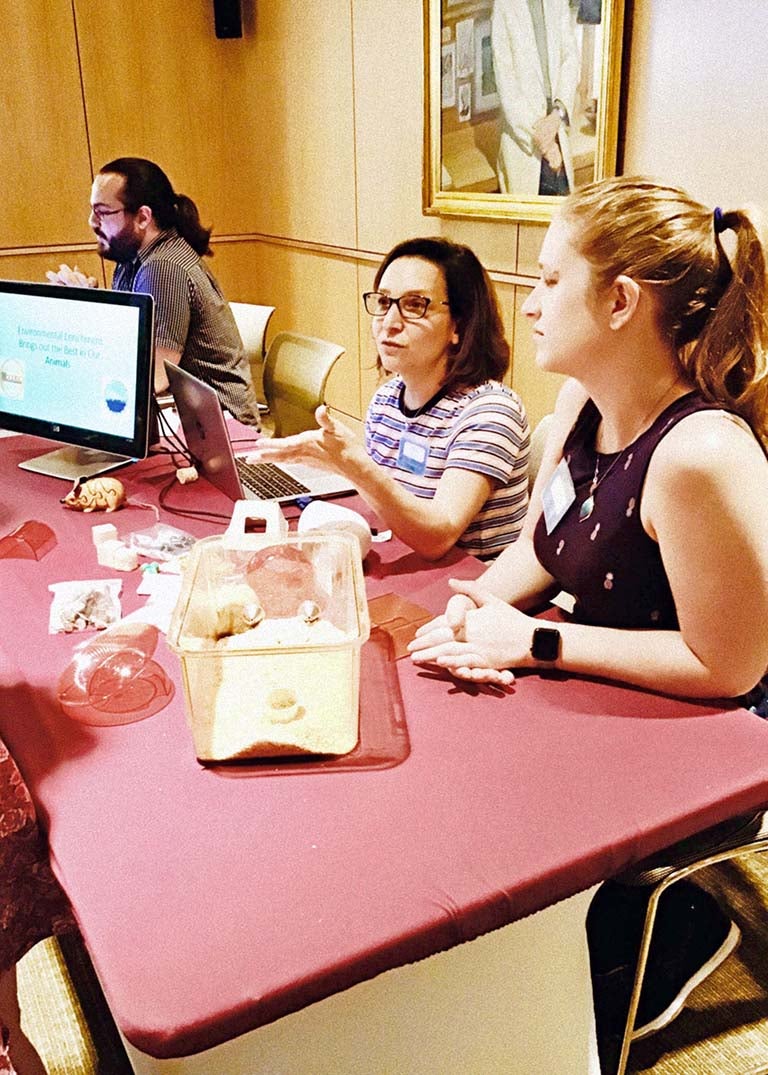
Rubino is required to join the Institutional Animal Care and Use Committee (IACUC), a CSHL oversight committee for looking at how animals are used. The committee is chaired by scientists, a vet, and a non-scientist member unaffiliated with CSHL. They oversee every single research proposal and protocol to make sure that they’ve answered all the questions on that protocol. This includes everything from how scientists provide pain relief, what anesthesia they’re using, if they can accomplish their goal using in vitro methods (which don’t require animal models), and whether they’re unnecessarily replicating studies.
The National Research Council’s Guide for the Care and Use of Laboratory Animals serves as a bible that sets the standards of everything from cage size to room temperature to protective measures. The Animal Welfare Act of 1985 is an ethical accompaniment, mandating environmental enrichment for animals. These regulations are constantly updated to maximize animal comfort.
“There’s been a considerable amount of research published recently on how we handle animals. It’s very common when you handle a mouse, you pick them up by the base of the tail to move them from cage to cage. That may potentially be stressful for them, because if they got picked up by a predator, they might have been caught the same way,” Rubino said. There’s still ongoing discussion about better ways to move mice; a suggestion was to use tunnels or hands to scoop the mice up.
The mouse and the machine
As of 2018, 180 of the 216 Nobel Prize award recipients in the Physiology or Medicine category used animal models in their research, according to the Foundation for Biomedical Research. Animals continue to be instrumental in a variety of research projects. Model organisms like mice are so commonplace in research institutions all across the world that NASA even sent a group of mice into space while their twins remained on Earth. The intent was to study changes in overall health and brain functions of the space-bound mice, as well as noting any changes in physiology, allowing NASA to better equip future astronauts.
Studying behavior in space shows mice adapt to micogravity.
As the human world changes, the scientific world typically follows suit. New technologies, like virtual reality, raise new questions and answer old questions. This prompts scientists to dispatch a handful of neat gadgets for mice to test, like placing them in a virtual reality video game to understand their vision, movement, memory, and smell.
Emerging and advancing technology can create new ways for studying and quantifying animal behavior. CSHL neuroscientist Anne Churchland creates complex sensory environments for mice in order to understand how the brain uses vision and hearing to guide actions and decisions. Her lab currently uses multiple high-quality videos of the animals to help researchers characterize movements with unsupervised learning tools. Better ways to track, measure, model and analyze behavior have helped neuroscience researchers develop a deeper understanding of cognition.
Lab mice are also providing the behavioral outline for computer scientists to design better artificial intelligence and more sophisticated robots. That adds another layer to standard behavior and cognitions tests for animals, simulating the animal in addition to the environment. The creation of artificial neural networks, or artificial model organisms, simulates the structure and correlated behavioral functions of a network of neurons in the brain. Churchland has argued that artificial networks that are trained to solve problems might be thought of as another kind of model organism, and perhaps both artificial networks and simple animals like mice can teach us a lot about human cognition.
The knowledge about mice anatomy and physiology can further help scientists develop programs to benefit the animal. Computer models or virtual laboratories, for example, can stand in for animal models during early stages of drug testing. Quantitative biology, which implements math and computer models to study living organisms, is used to track and predict how different drug compounds will interact with biological processes in living cells or organisms. These computer programs have been shown to outperform animal tests at predicting toxicity of potential drugs.
“The advancement of being able to make genetic modifications to animals has really changed the way that research is done, because we can recreate many of the genetic conditions in humans in laboratory animals,” Rubino said. “Now with the gene-editing tool CRISPR it’s even more rapid than it was when we were doing different methods of genetic modification in the past.”
The CSHL Cancer Center is also exploring the use of organoid technology, which can create three-dimensional human cell cultures complete with an extracellular matrix for incubating tumor cells. Compared to the previous two-dimensional in vitro models, organoids present a more realistic simulation of human cancer. “Organoids are kind of like a compromise between the speed and flexibility of cell lines, and the more realistic 3D tumor growth achieved in mice,” said Lindsey Baker, a research investigator in Dr. David Tuveson’s lab at CSHL. Organoids can ultimately reduce the number of mice needed in an experiment.
Regulations are continually updated as research advances into new territories of animal use. It’s up to animal lab directors and veterinarians like Rubino and her team to ensure researchers properly adjust the use of animal models as advancements allow them to address questions in other ways.
“The ultimate goal is to replace animal models, but we’re not there yet,” Rubino said. “As we create better models that minimize the need to use animals, newer issues may arise. My job is to stay ahead of those problems from a welfare perspective, and tell researchers about how that may affect the science.”
[Take our quiz to test your knowledge about the fascinating roles animals have played in the discovery of lifesaving drugs and other scientific achievements.]Written by: Charlotte Hu, Content Developer/Communicator | publicaffairs@cshl.edu | 516-367-8455
